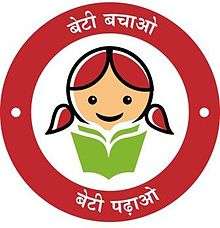Beti Bachao, Beti Padhao Yojana
| Beti Bachao, Beti Padao Yojana | |
|---|---|
 | |
| Country | India |
| Prime Minister(s) | Narendra Modi |
| Ministry | A joint initiative of MoWCD, MoHFW and MoHRD |
| Launched | 22 January 2015 |
| Status: Active | |
Beti Bachao, Beti Padhao (translation: Save girl child, educate girl child) is a social campaign of the Government of India that aims to generate awareness and improve the efficiency of welfare services intended for girls. The scheme was launched with an initial funding of ₹100 crore (US$16 million).[1] It has been the target of fraudsters in Uttar Pradesh, Haryana, Uttarakhand, Punjab, Bihar and Delhi.[2][3]
According to census data, the child sex ratio (0–6 years) in India was 927 girls per 1,000 boys in 2001, which dropped to 918[1] girls for every 1,000 boys in 2011. A 2012 UNICEF report ranked India 41st among 195 countries.
Speaking on the occasion of International Day of the Girl Child in 2014, the Prime Minister, Narendra Modi had called for the eradication of female foeticide and invited suggestions from the citizens of India via the MyGov.in portal.[4]
The Beti Bachao, Beti Padhao (BBBP) scheme was launched on 22 January 2015 by Modi..[5][6] It aims to address the issue of the declining child sex ratio image (CSR) and is a national initiative jointly run by the Ministry of Women and Child Development, the Ministry of Health and Family Welfare and the Ministry of Human Resource Development. It initially focused multi-sector action in 100 districts throughout the country where there was a low CSR.
In 26 August 2016, Olympics 2016 bronze medallist Sakshi Malik was made brand ambassador for BBBP.[7]
The hashtag #SelfieWithDaughter was promoted on social media in June 2015, which started when Sunil Jaglan the sarpanch of the village Bibipur in Haryana took a selfie with his daughter Nandini and posted on Facebook on 9 June 2015.[8] The hashtag garnered worldwide fame.[9]
Need
Sex-selective abortion or female foeticide has led to a sharp drop in the ratio of girls born in contrast to boy infants in some states in India. Ultrasound technology has made it possible for pregnant women and their families to learn the gender of a foetus early in a pregnancy. Discrimination against girl infants, for several reasons, has combined with the technology to result in a rise in abortions of foetuses identified as female during ultrasonic testing.
The trend was first noticed when results of the 1991 national census were released, and it was confirmed to be a worsening problem when results of the 2001 national census were released. The reduction in the female population of certain Indian states continues to worsen, as results of the 2011 national census have shown. It has been observed that the trend is most pronounced in relatively prosperous regions of India.[10] The dowry system in India is often blamed; the expectation that a large dowry must be provided for daughters in order for them to marry is frequently cited as a major cause for the problem.[11] Pressure for parents to provide large dowries for their daughters is most intense in prosperous states where high standards of living, and modern consumerism, are more prevalent in Indian society.
Rates of female foeticide in Madhya Pradesh are increasing; the rate of live births was 932 girls per 1000 boys in 2001, which dropped to 918 by 2011. It is expected that if this trend continues, by 2021 the number of girls will drop below 900 per 1000 boys.[12]
Strategies
Strategies employed to successfully carry out the scheme are:[13]
- Implement a sustained Social Mobilization and Communication Campaign to create equal value for the girl child and promote her education.
- Place the issue of decline in CSR/SRB in public discourse, improvement of which would be an indicator for good governance.
- Focus on Gender Critical Districts and Cit
Support
The Beti Bachao campaign is supported by the Indian Medical Association.[14]
References
- 1 2 "Archived copy" (PDF). Archived from the original (PDF) on 5 November 2014. Retrieved 5 November 2014.
- ↑ K Sandeep Kumar, Rajeev Mullick (19 May 2017). "UP govt sounds alert over Beti Bachao Beti Padhao scheme fraud". Hindustan Times. Retrieved 12 June 2017.
- ↑ Press Trust of India (28 March 2017). "Haryana govt cautions people against frauds under Beti Bachao-Beti Padhao scheme". The Indian Express. Retrieved 12 June 2017.
- ↑ "PM Narendra Modi invites ideas on "Beti Bachao, Beti Padhao"". DNA India. 11 October 2014. Retrieved 2016-06-12.
- ↑ "PM to Launch 'Beti Bachao, Beti Padhao' Programme from Haryana". Newindianexpress.com. Retrieved 2016-06-12.
- ↑ "PM Narendra Modi to launch 'Beti Bachao, Beti Padhao' programme from Haryana". The Economic Times. Retrieved 2016-06-12.
- ↑ "Sakshi Malik to be brand ambassador of 'Beti Bachao, Beti Padhao' campaign in Haryana". 2016-08-24. Retrieved 2016-08-24.
- ↑ Mohan, Rohini (30 June 2015). "How PM Modi's Beti Bachao, Selfie Banao campaign became a rage to rewrite gender-skewed script in Haryana". Economic Times. Retrieved 1 July 2015.
- ↑ Sanyal, Anindita (28 June 2015). "#SelfieWithDaughter Trends Worldwide After PM Modi's Mann ki Baat". NDTV. Retrieved 1 July 2015.
- ↑ Selections from regional press, V. p. 68.
- ↑ Panwar, Preeti (June 29, 2012). "Female foeticide: Death before birth". Bankersadda. Retrieved September 27, 2012.
- ↑ Gupta, Suchandana (October 3, 2011). "Skewed sex ratio: MP launches 'Beti Bachao Abhiyan'". Times of India. Retrieved September 27, 2012.
- ↑ "Beti Bachao Beti Padhao — Vikaspedia". Vikaspedia.in. Retrieved 2016-06-12.
- ↑ "Indian Medical Association". Journal of the Indian Medical Association. Indian Medical Association. 105 (7-12): 711. 2007.